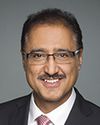Thank you very much. The time is up.
Maybe you can try to get some of those answers in with other people's questions.
Mr. Aubin.
Evidence of meeting #44 for Transport, Infrastructure and Communities in the 42nd Parliament, 1st Session. (The original version is on Parliament’s site, as are the minutes.) The winning word was bank.
A video is available from Parliament.
11:20 a.m.
Liberal

The Chair Liberal Judy Sgro
Thank you very much. The time is up.
Maybe you can try to get some of those answers in with other people's questions.
Mr. Aubin.
11:20 a.m.
NDP

Robert Aubin NDP Trois-Rivières, QC
Thank you, Madam Chair.
My thanks to the minister for being here with us today.
Since six minutes pass by quickly, I will start right away.
My first question came to me after reading the parliamentary budget officer’s latest report. In the report, there’s a graph showing the distribution of investments in infrastructure. Since we’re dealing with investments in infrastructure, it is not unreasonable to imagine that there should be a relationship between infrastructure and the percentage or density of the population in each of the provinces and territories. However, when I look at the numbers, Quebec, which has more than 8 million people, receives 12% of the investments, that is 1% more than Alberta, which has 4 million people, and 5% less than British Columbia, which has about 5 million people. Those are rounded numbers.
How do you explain those disparities?
11:20 a.m.
Liberal

Amarjeet Sohi Liberal Edmonton Mill Woods, AB
When you look at the phase one overall infrastructure investment allocation, even though different funding streams have different ways of allocating, overall it is matched to the population so that each province has received its fair share.
They might have received a little less in transit or a little more in transit, or a little more in waste water infrastructure or a little bit less in waste water infrastructure, but if you merge all those projects together, it evens out, based on the population of the province, with maybe a bit of discrepancy.
11:25 a.m.
NDP

Robert Aubin NDP Trois-Rivières, QC
Thank you.
My second question deals directly with the Infrastructure Bank.
I would like to understand the relevance of one aspect. My understanding is that $15 billion that was already earmarked for infrastructure is being taken away and placed in a bank to serve as leverage and to attract private funding.
If the interest rates were at 24%, I would have understood the desire to bring together the largest players around a table to try to negotiate the best possible rates. However, under the current circumstances, infrastructure projects will be financed with private funding that requires a 7% to 9% return, as Mr. Sabia said, when the government could very well finance the same project at a lesser cost.
Where is the real benefit for taxpayers?
11:25 a.m.
Liberal

Amarjeet Sohi Liberal Edmonton Mill Woods, AB
We have committed to doubling of infrastructure investments over the 12 years. That's more than $180 billion. Despite doubling those investments, there remains a large gap in what communities need and how much infrastructure we need to build and how much infrastructure we need to maintain. The role of the bank will be to build more infrastructure on top of what we would traditionally build through funding that is available through these funding streams.
11:25 a.m.
NDP

Robert Aubin NDP Trois-Rivières, QC
Mr. Minister, allow me to say that the projects funded by the Infrastructure Bank will be very rarely—I don't want to say “never”—projects supported by municipalities like mine and many others in Quebec and across the country because they do not have projects of that magnitude.
Will the Infrastructure Bank put a brake on the VIA Rail high-speed train project, for instance?
11:25 a.m.
Liberal

Amarjeet Sohi Liberal Edmonton Mill Woods, AB
One thing that I want to make absolutely clear is that whether municipalities or provinces want to use the bank to build infrastructure is optional, and they will still continue to receive their fair share of the funding under the traditional programs where there's a national program or opportunity.
February 9th, 2017 / 11:25 a.m.
Jean-François Tremblay Deputy Minister, Office of Infrastructure of Canada
Let me make a clarification.
The money going to the bank is additional money. It does not come from the funding earmarked for the provinces. The provinces can still use the current and future programs. By establishing the Infrastructure Bank, the government is adding a tool that does not exist right now in order to review projects that require a different type of funding. However, that will not eliminate the traditional programs already in place.
11:25 a.m.
NDP

Robert Aubin NDP Trois-Rivières, QC
I understand, but based on what I have seen, the projects that will be studied by the bank and ultimately funded by it, must have a minimum—
11:25 a.m.
Deputy Minister, Office of Infrastructure of Canada
For the time being, we cannot speculate on the types of projects, but those introduced by governments will have to be approved by the governments in question.
11:25 a.m.
NDP

Robert Aubin NDP Trois-Rivières, QC
So there’s no floor or ceiling for investments?
Could any project qualify for the bank?
11:25 a.m.
Deputy Minister, Office of Infrastructure of Canada
What matters to us is that the projects are able to attract outside investment. That is the primary criterion.
11:25 a.m.
Liberal

Gagan Sikand Liberal Mississauga—Streetsville, ON
Thank you, Minister, for being here today.
Having been here nearly two years, it's apparent to me that the government needs vast revenue streams coming in. I also wholeheartedly reject anyone who espouses the position that it's only through taxation that we get that money.
Now having said that, I was very pleased to see that the mandate here states that investments will be made in revenue-generating infrastructure projects and plans that contribute to long-term sustainability. Could you elaborate a little on this?
11:30 a.m.
Liberal

Amarjeet Sohi Liberal Edmonton Mill Woods, AB
As I said in my remarks, there is a vast majority of infrastructure that will have no need for the bank because there's no revenue attached to it.
We see the role of the bank in cases where there's a potential revenue or existing revenue that can be generated by the building of that infrastructure. Transmission infrastructure, for example, has revenue attached to it, so why would we not look at the bank to build that kind of infrastructure that is necessary? It also frees up the government resources that we can use to build more infrastructure where there's no revenue attached. That is one example.
11:30 a.m.
Liberal

Gagan Sikand Liberal Mississauga—Streetsville, ON
What happens if one of the approved projects goes bankrupt?
11:30 a.m.
Liberal

Amarjeet Sohi Liberal Edmonton Mill Woods, AB
The role of the bank is to enable investment in infrastructure projects that are traditionally not possible for the private sector or for the public sector. With regard to whether we take an equity stake in it or whether we provide loan guarantees, extensive analysis will be done done prior to the approval of the projects. This will also be done by the other stakeholders and partners because the majority of the infrastructure that we fund is either owned by the municipalities or the provinces.
There are three levels of due diligence done on a project. It is done not only by us, but also by the municipality and by the province.
11:30 a.m.
Executive Director, Canada Infrastructure Bank Transition Office, Office of Infrastructure of Canada
Any infrastructure project, whether it's a public procurement, a PPP, or something that will be engineered by the bank, will have appropriate legal covenants and agreements that address the fairly routine occurrence, sometimes, of incidents of default. This not uncommon. It's quite routine. Even in the largest complex deals that the bank would be involved in, it is expected to follow common practices in that circumstance.
11:30 a.m.
Liberal

Gagan Sikand Liberal Mississauga—Streetsville, ON
I just have a real-world example, and I know I asked you this last time. The missing link project in Mississauga, would that be the type of project that could access the bank?
11:30 a.m.
Liberal

Amarjeet Sohi Liberal Edmonton Mill Woods, AB
To know whether the project you're referencing can be funded through the bank, we would have to see the proposal. Projects that are not able to be funded through the bank will still be funded through other infrastructure projects. We will not say to municipalities that if they don't use the bank, they won't qualify for other funding. It's all optional and it's all discretional on the part of our partners.
11:30 a.m.
Liberal

Gagan Sikand Liberal Mississauga—Streetsville, ON
Thank you, Minister.
I'd like to give the balance of my time to Mr. Tootoo.
11:30 a.m.
Independent

Hunter Tootoo Independent Nunavut, NU
Thank you, Madam Chair.
Thank you, Mr. Sikand.
Welcome, Minister. It's good to see you. I was very pleased to hear you say in your opening comments that when it comes to infrastructure investment, “the status quo is no longer acceptable”.
I can't think of a jurisdiction where that's truer than in my riding of Nunavut, where a dollar down here is 33 cents up there, where the highest cost of doing anything up there is three times as much, and where we have only one out of 25 communities that is tax based.
I think there's a need to look at a base-plus funding model to be able to address those needs. It's no secret that we have a huge infrastructure deficit in Nunavut as a result of the ongoing traditional way of doling out investment on a per capita basis. We have the largest land mass, a small population, and high costs, with hardly any infrastructure.
One thing I've always said in terms of any investment in the north is that one important thing to remember is that for us everything we need for infrastructure comes from the south, so it is an investment in the north but it's also a significant investment in the southern economy as well.
When it comes to the infrastructure bank, I know that the northern premiers have said there should be a northern infrastructure bank. I guess I'm just wondering if there will be a portion of this that will be dedicated to northern infrastructure, and if they will be looking at a different way of making that investment, aside from the per capita basis.
11:35 a.m.
Liberal

Amarjeet Sohi Liberal Edmonton Mill Woods, AB
We listen very carefully to our partners at the provincial, territorial, and municipal levels. We've designed our plan to be flexible, and we will continue to do that. We will not have the cookie cutter approach that was applied in the past.
For the northern communities, we've heard very clearly that the needs are different and that we need to have different criteria in supporting those communities. In the territories, their needs are different. That's why we created the $2-billion northern and remote communities fund. We will be looking at a different cost-sharing for that program, because we know that costs are much higher in northern communities than in other communities.
We are also working with the premiers in the territories and looking at the utilization of the bank to build some of the infrastructure they need. Those discussions are progressing.